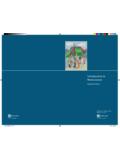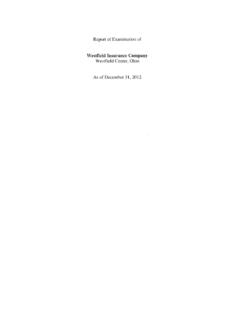Transcription of GLOSSARY OF ACTUARIAL AND RATEMAKING …
1 Page 1 of 8 GLOSSARY OF ACTUARIAL AND RATEMAKING terminology Term Definition Accident An event or occurrence which is unintended, unforeseen and unexpected; something which could not be considered as a foreseeable occurrence and consequence of an undertaking; a casualty; mishap. Accident Date The date of the event which gave rise to the claim. Accident Period Period in which an accident occurs, regardless of when the policy covering it is written, when the occurrence is reported, or when the associated claims are closed and losses are paid.
2 Accident Year Case-Incurred Losses The sum of all paid losses and case reserves for a specific accident year at a specific point in time. Accident Year Experience Loss experience calculated by matching the total value of all losses occurring during a 12-month period with premiums earned for the same period. Acquisition Cost The cost of selling insurance; normally the agent s and broker s commission; any cost of putting the business on the books. Actuary A social mathematician who uses mathematical skills to define, analyze and solve complex business and social problems involving insurance; the work of actuaries involves the various contingencies which face human beings and the financial effects which such contingencies have on various insurance programs.
3 Many of these programs involve long-range financial obligations, for which ACTUARIAL forecasts are fundamental in maintaining a sound financial basis - rate-making, premium and loss reserving, investment valuation, pension benefits, and insurance statistics, among others. Adverse Selection (Anti-Selection, Selection of Risk) The conscious and deliberate selection of risks, segments of risk, or coverages that appear less attractive, with a higher chance of loss, than that contemplated by the applicable rate; the selection of such risks is adverse because the rate is inadequate; a tendency towards insuring risks possessing negative characteristics.
4 Aggregate (Aggregate Limit) The dollar amount of insurance coverage during one specified period, usually 12 months, for all insurance losses sustained during such period; the maximum amount of coverage under an insurance policy or funding arrangement; a limitation of the total amount of losses covered by the insurance contract or self-insurance funding during a given period. Allocated Loss Adjustment Expense (ALAE) A monetary payment or reserve used to cover expenses incurred in settling claims; ALAE are those expenses, such as investigative fees, court fees and outside legal counsel, directly attributable to and associated with settling a particular claim.
5 Annual Statement (Statutory Annual Statement, Convention Blank) The annual report format prescribed by the NAIC and the state departments of insurance; provides a summary of the company s financial operations for a calendar year, including a balance sheet supported by detailed exhibits and schedules; is filed with the state insurance department of each jurisdiction in which the company is licensed to conduct business. Base Rates A manual rate applied to a class of policies or to similar characteristics of a particular risk in a given territory or classification for a basic limit of liability; price per unit of insurance.
6 Basic Limits The minimum amounts of insurance for which it is the practice to quote premiums in liability insurance; additional amounts are charged for by the addition of certain percentages of the premium for the minimum (basic) limits. Calendar Year Experience Loss experience calculated by matching total value of all losses incurred during a given 12 month period with the premiums earned for same period. Case Reserve The estimated amount of a claim payment; the sum of the values assigned to specific claims by the entity s case reserving procedure.
7 Claim A demand received by an insured for damages resulting from a medical incident, event or occurrence. Page 2 of 8 Term Definition Claimant The individual or entity making a claim against an insured; one who has suffered a collectible loss; plaintiff. Claims-Made (Claims-Made Coverage, Claims-Made Basis) A coverage form that provides coverage for claims reported during the policy term or funding period which occurred subsequent to the retroactive date of the coverage, and prior to the end of the policy term or funding period; once the policy period is over, the approximate extent of the insurer s liability is known.
8 With claims-made covers which are renewed, losses which occurred during any period when the policy was inforce are covered if reported during the renewal term. Combined Ratio (Trade Ratio) The sum of the Incurred Loss Ratio and the Expense Ratio. Credibility The relative confidence ascribed to historical loss experience; the value is usually expressed in terms of specific mathematical formulas and is a number between zero and one (100%); a measure of the predictive value attached to a particular body of data; a measure of statistical reliability, credence or believability; as the body of experience increases in volume, the corresponding credibility also increases.
9 Discounted Reserve The present value of the payment of outstanding losses and loss adjustment expenses in the anticipated future settlement amounts, calculated at selected interest rate(s). Earned Exposures The exposure units actually exposed to loss during the period. Earned Premium That part of premium applicable to expired portion of policies insured, or that part earned under an insurance policy; includes the short-rate premium on cancellation, the entire premium on the amount of loss paid under some policies, and the entire premium on the contract on the expiration of the policy; that portion of the insurance premium calculated on a monthly, quarterly or annual basis which is to be retained by the insurer should the policy be canceled.
10 When a premium is paid in advance for a certain time, the company is said to earn the premium as the time advances, for example, a policy written for three years and paid for in advance would be one-third earned at the end of the first year. Excess Insurance (Excess Program) Refers to insurance that provides protection for losses greater than a specified amount. Expected Loss Costs The loss costs at the mean confidence level; those losses associated with the arithmetic mean; the expected value of the probability distribution of the amount of loss which may occur during one defined period; normal loss.





